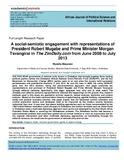Please use this identifier to cite or link to this item:
https://cris.library.msu.ac.zw//handle/11408/3496Full metadata record
| DC Field | Value | Language |
|---|---|---|
| dc.contributor.author | Mapuwei, Nyasha | - |
| dc.date.accessioned | 2019-03-29T07:51:26Z | - |
| dc.date.available | 2019-03-29T07:51:26Z | - |
| dc.date.issued | 2014 | - |
| dc.identifier.issn | 1996-0832 | - |
| dc.identifier.uri | http://hdl.handle.net/11408/3496 | - |
| dc.description.abstract | THE FIVE-YEAR government of national unity tenure in Zimbabwe that brought together three leading political parties namely the Zimbabwe African National Union-Patriotic Front (ZANU-PF), and the two Movement for Democratic Change (MDC) parties came to an end when the country held successful parliamentary and presidential elections in July 2013. As was the case in 2008, the ruling ZANU-PF party won the 2013 election. Using the social-semiotics approach, this paper examines the representations and portrayal of President Robert Mugabe and Prime Minister Morgan Tsvangirai through editorial cartoons. Specifically, this paper assesses how, why and to what extent The Zimdaily.com editorial cartoons representations reflected the happenings on the ground. Key research methods used in this study are qualitative archival research, textual analysis, semiotics and content analysis. Based on the mass communication theories of gate-keeping, agenda building, representation, media and political economy theories, this paper argues that old fashioned conflict resolution and conflict prevention tactics and strategies need to be improved as the modern society becomes networked than ever. It was clear that peace building approaches such as those recommended by the 1992 United Nations resolution could not apply to Zimbabwe, but modern societies such as those found in Zimbabwe need a multi-task diplomacy approach such as the one employed by the then South Africa President Thabo Mbeki in resolving the Zimbabwean problem. The Zimbabwe conflict had become a sub-continental problem and could have spilled into an armed violence or even an insurrection but for the regional intervention and other multi-task diplomacy approaches, as manifesting through the editorial cartoons, the result was the government of national unity and not war. | en_US |
| dc.language.iso | en | en_US |
| dc.publisher | Academic Journals | en_US |
| dc.relation.ispartofseries | African Journal of Political Science and International Relations;Vol. 8, No. 7: p. 236 - 243 | - |
| dc.subject | Diaspora media | en_US |
| dc.subject | Inclusive government | en_US |
| dc.subject | Regime change | en_US |
| dc.title | A social-semiotic engagement with representations of President Robert Mugabe and Prime Minister Morgan Tsvangirai in The ZimDaily.com from June 2008 to July 2013 | en_US |
| dc.type | Article | en_US |
| item.fulltext | With Fulltext | - |
| item.languageiso639-1 | en | - |
| item.openairecristype | http://purl.org/coar/resource_type/c_18cf | - |
| item.grantfulltext | open | - |
| item.openairetype | Article | - |
| item.cerifentitytype | Publications | - |
| Appears in Collections: | Research Papers | |
Files in This Item:
| File | Description | Size | Format | |
|---|---|---|---|---|
| 111- research papers - Social semiotic engagement - paper 1.pdf | Full Text | 76.13 kB | Adobe PDF |  View/Open |
Page view(s)
154
checked on Oct 9, 2025
Download(s)
60
checked on Oct 9, 2025
Google ScholarTM
Check
Items in MSUIR are protected by copyright, with all rights reserved, unless otherwise indicated.



